| |
| |
MT:
Talking about the Drowned World Tour on the classic 2001
"Entertainment Design" interview you said that
director Jamie King showed you hundreds of photographs and
artistic renderings - things that were not necessarily related
to the show, but ideas that he was drawing from.
We had a chance to talk to Jamie and learned how his work
with Madonna is heavily inspired by the images he runs across,
a sort of visual collection of different inspirations.
Which kind of images did he show you for the Drowned World
Tour?
|
|
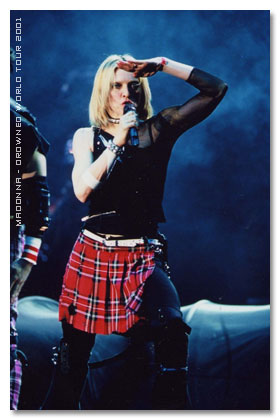 |
PM: He brought up some images that ended
up actually being personified on stage, it's interesting.
That was definitely a very heavy source of direction,
a very definite source of direction which was priceless.
It was the biggest help of all.
He would bring up hundreds of photographs (laughs), I
really mean hundreds.
I don't know where he went to find some of the stuff (laughs)
but a lot of things actually became reality in the show
and I can't specify any one image unfortunately but I
do remember in Ray Of Light... I remember there were certain
images that I took with me and studied them and actually
"copied" them so that we could illuminate the
same way.
We really ended up with some moments that could have been
snapshots of those same photos and images he showed me
originally.
I feel we went full circle on that. I've got some photos
from that show that literally show the same feel if not
the same imagery that he showed me initially. It's great
working with Jamie that way because he has a great idea
of images before he starts and that's important.
I've worked with set designers, choreographers, show directors
in the past and they have no idea about what colours to
use, how something should look, they only a feeling for
it is they're doing specifically but not the end product.
Jamie has the entire end product in view from the beginning.
Basically he just brought us all on board.
MT: Let's talk about the so-called "spaceship",
the powerful element from the Drowned World Tour stage.
I understand that was a big challenge to deal with, can
you tell us a bit more about it?
|
|
| |
PM: Pretty much the entire stage
was a challenge, the way Bruce Rodgers designed it was great.
We had the flying to deal with and we had the scenary that
moves and all this mechanism that went into putting the
show on took up space and unfortunately lot of the time
it was the space I needed for lighting.
I knew that the "spaceship" had to be a lighting
element but it also had to be a scenic element so fortunately
for the existence of that piece I was able to hang lights.
It also had led pannels which was a great experiment. Most
people are used to seen an unbroken seamless video wall
and here we were taking images and presenting them on these
small blocks of video. They weren't small images, it's hard
to explain, it was like if you could fill the checker board
over a video wall and take the black squares out, that was
what missing.
And yet the eye connected these images and it was really
magical. So it was a scenic piece, it was a video piece
and it was a lighting structure at the same time.
|
|
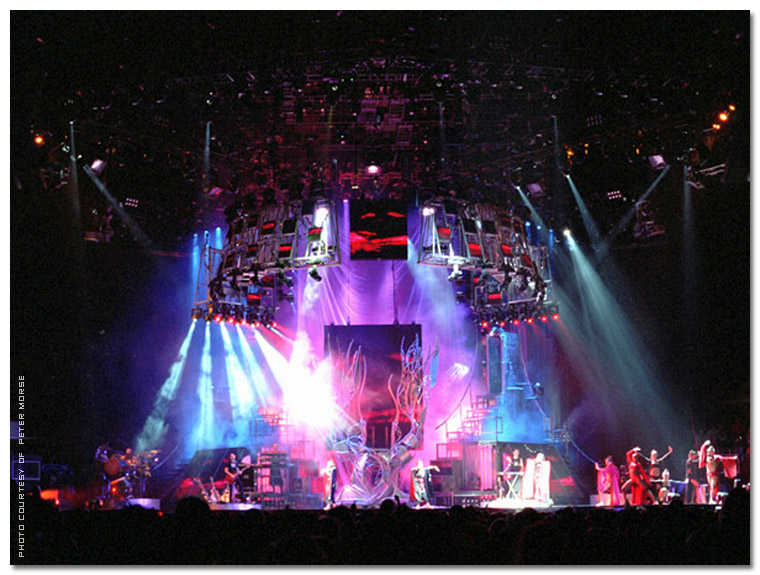 |
| |
MT: You also said
that having weeks of physical rehearsals, without the stage
gave you an opportunity to sit in and see Madonna run through
things, so to start getting ideas and make changes as you
went into the ongoing design of the system.
PM: Most of the
time I feel I'm wasting my time and the artist's time and
money to sit around in early dance rehearsals and watch
them pick through some ideas and changes. |
|
| |
It's much more efficient for me to go and watch run throughs
when they actually got it all together and they are just
running it on a stage, so I get an idea of timing and so
forth.
What I instinctively felt on this show, especially with
the early introduction of all the images that Jamie showed
me, I felt instinctively that it was important to be there
at some of the early rehearsals and watch them as they grappled
with some of the technical challenges of dancing especially
the flying/fight scene.
I wanted to see how that was all put together because I
started building ideas along with them in my own mind and
essentially by the time it was finished and they were running
it non stop I already had a fairly clear idea of what I
wanted to do. It helped me a lot giving me a better understanding
of what Jamie was trying to do.
MT: Did you have
to work on speficic songs that didn't make the final setlist?
I understand there were some changes made so does this affect
your job? |
|
| |
PM: It doesn't really, certainly there
are elements we put in the design that are specific for
certain songs. If the song is taken out those elements are
used elsewhere sometimes or sometimes they are taken away
from the show.
The biggest issue is blending from one song to the other
when you're computerizing lights you can't all of a sudden
say: ok song's over, here's the first cue for the next song.
'Cause you will have light just flying out of nowhere to
get to where they belong so you need to build blind links
between songs so that the light can be pre set. Obviously
with the automated fixtures that we use now they have multi-functions.
So when they would change the order or pull songs it affects
us techinically but that's what rehearsals are there for.
|
|
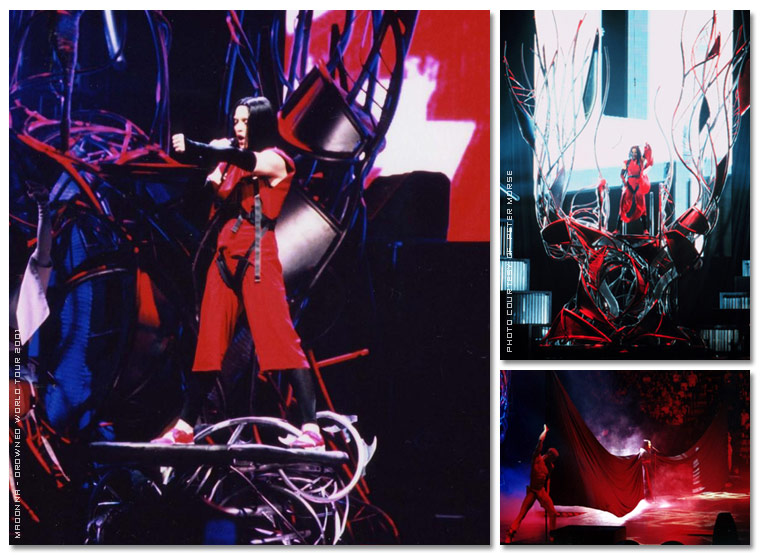 |
| |
MT: There seemed
to be many different types of light sources that have been
used to light the Drowned World Tour?
PM: There were quite a few fixtures that
had specific application in the show. We had a fixture,
the 3000 watt Syncrolight, which are like search lights,
and it was specific for the Samurai number when he was in
the tree, we had a specific look for that and that light
was there for that purpose only, this brings up an interesting
moment.
When she was downstage center with him [Nobody's Perfect]
I made a decision not to light that with any front light
at all. That was entirely lit with back light or what I
call three quarter back light. Nothing from the side, nothing
from the front, all kind of siluette and that was my decision,
I just had a feeling.
|
|
| |
It was really
dramatic and such a beautiful choreography I really wanted
to see it without the spotlight.
I said to Jamie: I want to try it this way. And I told
Madonna: Don't be alarmed I'll be giving it a try. And
of course they love to experiment so it felt right in
line with everything. So there is no front light on her
in that number and I brought it to life.
MT: In the Drowned World Tour programming
had a strong role in the way the music was played on stage.
How did this affect the way you control the various lighting
devices? How was setting up the various timelines like?
PM: Well this brings us back to one of
the previous questions where I was saying that the element
of music is very important in all of her shows.
When I program I don't like using a music cd, I like using
a live video recording of the rehearsals with her especially
because ok, if I was lighting a band all I need is a cd
because we are lighting the music.
|
|
| |
But the interesting challenge with Madonna is that we're
not only lighting the music but we're lighting the visual
reality of what's going on on stage at the same time so
I need it all in front of me and as the music would edit
that would have a large effect on us because we obviosly
lit per the music per the choruses.
And all that was put together as a pieces of a puzzle. All
of a sudden they took four bars of music off, so we had
to lose four bars of lighting and we had to tie the other
two together in such a way it looked seamless.
So it was as big challenge for us as I'm sure it was for
the musicians when they had to do musical changes.
|
|
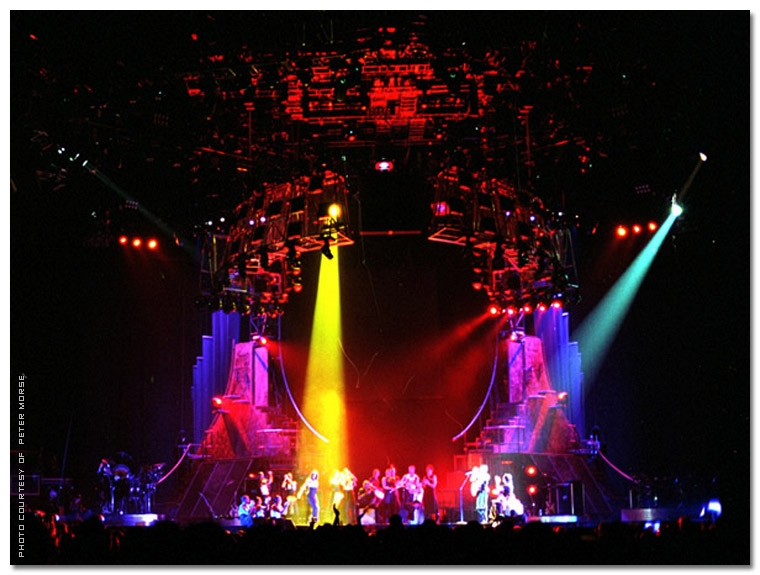 |
| |
MT: Did you happen to follow the shows
on the road as lighting director as well or your envolvement
ended once the tours were ready to start?
PM: Yes, Blond Ambition I stayed on as lighting
director, in Who's that girl I did not stay on but I came
out and directed the show, the video shoot for television
we did in Turin...
MT: The main part of the dvd comes from
that footage actually...
PM: The unfortunate part of that evening
was that I was brought in to re-do it but it was only a
week's notice so in reality I felt there were a lot of blue
sense in the live shoot that would not have been there had
I had more time with it but not being on the tour that time
had its effect.
|
|
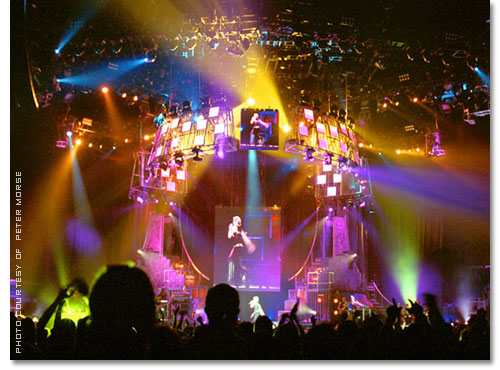
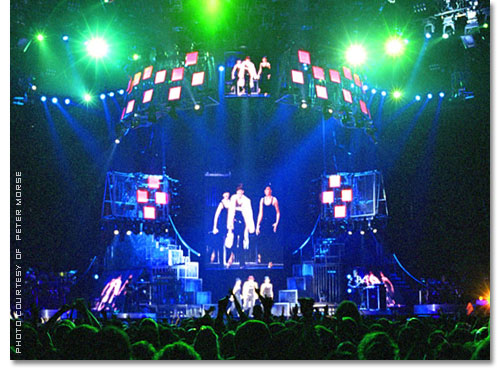
|
Then, there's the Girlie Show. The Girlie Show I did not
tour with. Now, lately when I do a show I go out for a month
or three to four weeks and make sure everything is seamless
and then I can leave. Girlie show was the same thing, I
got involved again when we shot it for video in Australia,
and I was involved of course with the television shoot for
Blond Ambition too.
On Drowned World I stayed with it for a few weeks and then
left it in the hands of the lighting director, that was
in Europe. When it came back to the Us, I came back out
for about a couple of weeks just to make sure everything
was seamless on it because we were changing types of stages,
and adjust technical problems.
Then I would go out about once a month with it and just
check on it and of course when we went to camera again I
was there for that.
MT:
So you had the chance to "experience" Madonna
fans in many concerts...
PM: Well the best thing about her fans is that
the event of the Madonna concert begins the moment the doors
open.
I think the entertainment begins the minute the doors open
because she has some fans that are so die hard that it's
a show in itself when they come in and of course the energy
begins, again, the moment the doors open and it doesn't
end until the last person leaves the building. I can't say
enough about it.
Madonna shows are 100% as far as energy but you have another
100% over that with the fans. It's unlike any other shows
I've ever worked on, I mean I've done Michael Jackson and
many more but Madonna has the most dedicated core of fans
that know her music inside out and want to be surprised
yet never are because no matter what she does to surprise
them they expect it.
They go right along with her, they take the ride right with
her, it's just wonderful. And you know it's interesting
because with Drowned World we were on the road a week and
there were people in different countries coming in and they
knew what to look for.
|
|
| |
The word was out and some of them just traveled through
Europe to see the show every night. The most dedicated group
of fans I've ever seen and those who aren't dedicated but
are just casual fans who come to see the show when it's
in their area it's the same energy.
MT: Is there a difference between fans in Europe
and fans in the US?
PM: A big difference and I can't explain
it. It's funny we actually had different areas of response
between the two continents. When we were in Europe we got
used to the crowd's response in a certain way and it was
wonderful. I can't remember any particular moment but I
do know when we came to the Us we had
just as energetic response but it would come at different
moments of the songs. It's very interesting, they just reacted
differentely depending on where you were. Very true.
|
|
|
MT: Working on the Blond Ambition Tour
you were also in charge of the ligthing of the footage Alek
Keshishian filmed for the "Truth or Dare" documentary.
How was that experience like?
PM: It was great, when they first started with
the archival cameras which followed us on tour they said
"we're shooting behind the scene footage that will
be put into a film" we all felt she had lost her mind
(laughs).
We were all out there trying to be natural in front of the
cameras while we were trying to do our work but obviously
always aware of cameras looking at us.
One of my favourite scenes I should have been in got dropped.
The producer at the time called me one day saying "I
want you to know one of my favourite scene got dropped from
the black and white documentary footage" which is when
we had our opening in Japan and in one of our first rehearsals
in front of a partial audience, the first rehearsal with
spotlights, we had a meeting in her dressing room right
afterwards and it was a bit of a disaster (laughs).
There she confronted me and said "Peter what is going
on with the spotlight? What is the story there?" and
I replied "Japanese, they don't understand me!, I know
a little Japanese but not enough".
She said: "Ah... ok, what will you do about that? What
about an interpreter?" I said "well by the time
the interpreter arrives..." you know it was a fun discussion,
everyone was laughing.
They loved the scene but it got dropped.
The fun part of working with Alek was that he was there
the entire time as was I so when he was developing his ideas
for the live shoot in Paris, he would sit and talk to me
about things he needed to change or alter for the film shoot.
The magic of that shoot is the fact we shot it on 35 millimiter
film and that's what made that so rich. To me, my favourite
footage of anything I've been involved in, is that footage,
because of the use of film opposed to video.
|
|
| |
We had some scary moments on Drowned World and it was all
due to video. Film is so much more forgiving and it has
a richer feel.
MT: Was the whole show shot on 35 mm film?
PM: I'd love to see some of that footage
that wasn't use. Because obviously only pieces were used.
You know, the entire show is shot in 35mm and the irony
is that it was never released and I think that it was probably
one of the most beautifully shot shows.
The director of photography was brilliant. His name is Toby
Philips. He did the Girlie Show also. He's incredible.
We did also shoot on video the show live from Nice for HBO...
|
|
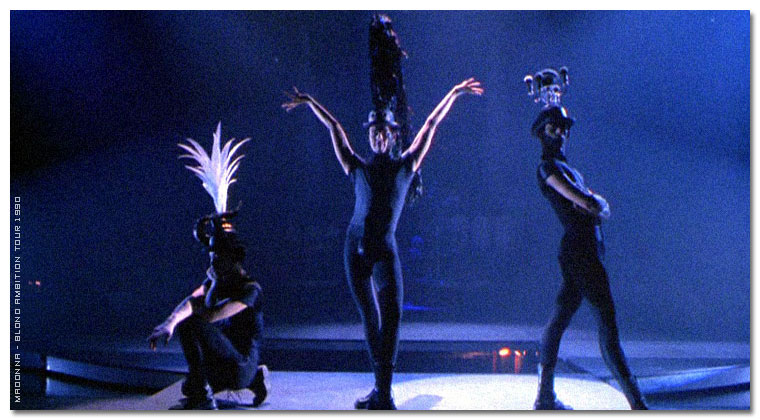 |
| |
MT: Yes, the Nice show was later released on Laserdisc
in the US and Europe. And now fans are longing for the Blond
Ambition to finally come out on Dvd...
By the way, did you have to change a lot of things in lighting
for the tv broadcast or video shoot?
PM: With Girlie Show we started using live
video, so the advantage to that is that we were already
lighting for camera with the start of the tour. There's
a distinctive difference between live lighting and what
works on camera.
In Blond Ambition when we were getting ready to shoot the
live video in Nice I spent three 12 hour nights with the
video lighting director, going cue by cue and changing looks
that would contamine her face or put a pattern on her face,
you know cleaning all the stage looks so that whatever she
moved she was consistently the same.
Exactly the same for close ups.
In film you don't have to do that, because film is totally
different, it's much warmer. Video is very difficult because
it's one thing when we have one or two cameras on her on
a tour but all of a sudden we have 14 cameras and all those
different angles.
We have to cover all those problems that arise when a camera
is shooting from behind or on the sides.
|
|
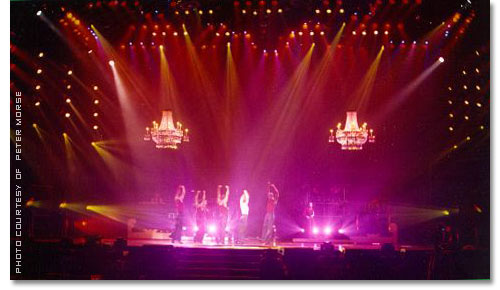
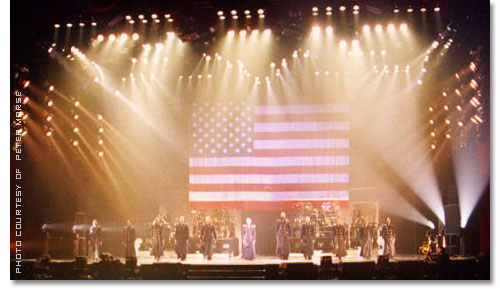
|
You know what might look good when you're looking at her
on the front might not look that well if you look behind
her. So we have to come up with ways to make that effect
happen without looking so bad on her. So video is a challenge,
we have to get our lighting levels balanced and it changes
the show considerably.
MT: Both the Blond Ambition Tour and Girlie
Show concerts gave you the chance to win an ACE Award as
Director of Photography and Lighting Design and Direction.
What are your memories of being awarded for your work on
them?
PM: It was a high point, I since won an emmy too
but the ACE was the first thing I ever won.
To be honest with you, it just felt right to get it for
Blond Ambition (laughs) because when we got it I was shocked,
I was happy, Alan and I both won it, but I understood it,
because I really knew we've done a good job and it wasn't
just us, it was that whole picture that was presented from
the artist going down, that's what I felt on that tour that
I don't feel with many other tours, and again on Girlie
Show, the magic about that tour was the fact that we were
really getting progressive and different and challanging
with her looks and everything.
I felt we nailed that one too and that was again a great
honour. It really was. But listen, whatever I won I appreciate,
I like to think it's for my work but it wouldn't have meant
anything without her being there, without her music and
the set designer who did the great set. It all comes together,
they all deserve a piece of that award.
|
|
| |
MT:
In your star-filled carrer, you had a chance to work with
an amount of incredible artists and musicians.
On the Ricky Martin "Livin' La Vida Loca" tour
you teamed up with great talents and professionals you worked
again with in the future. How was the Ricky Martin tour
experience like, and how is working with Jamie King, Bruce
Rodgers and Dago Gonzàlez?
PM:
Jamie [King] and I worked together before that but in different
roles when he was Michal Jackson's stand in. On the Dangerous
tour he was one of his lead dancers and we did some magic
gags and he became Michael Jackson a couple of times so
that Michael could magically appear elsewhere.
So we worked together there but certainly not in the role
we worked together on as lighting designer and show director.
So that was Ricky Martin which was the first time. It was
interesting because I never worked with Jamie in that role
and we just felt together like pieces of a puzzle, it was
just natural and Dago is brilliant and Bruce.
What I can say is that it was a really happy family. Dago,
Jamie and I worked on a show in Vegas called Storm. I've
always been comfortable with Jamie, we get along great,
we had great time together and I think we got the point
where we had unwritten comunication, unspoked communication.
We've done several shows together, Christina Aguilera and
a couple of other things.
|
|
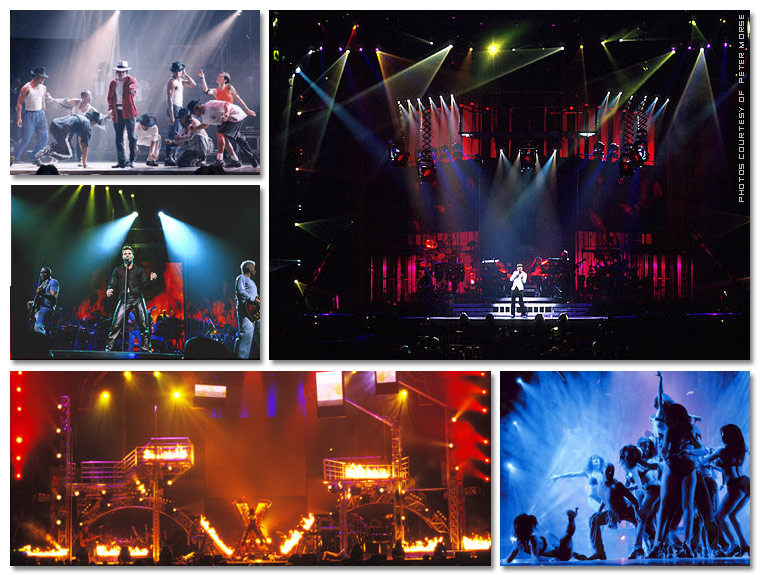 |
| |
MT: Let's talk about the importance of videos in
live shows. I think Drowned World Tour was the real turning
point in this trend. The screens were already huge but there
was still space for strong lighting. It's slowly evolved
and video is taking a major role all of a sudden in the
forefront...
PM:
That's true. In shows I've been working on recently and
one I'm working on for December videos have a very important
role. I just think is a natural evolution as technology
improves it will be used more and more. In fact I see the
day when video might become our writing source.
First of all I think video was used brilliantly in the Drowned
World Tour, those beautiful images by Dago and Jamie complemented
the show.
|
|
| |
When they come and shoot it for broadcast it's natural that
the director knows he's not there to shoot a wide shot,
he's there to shoot close ups cause the average person sitting
in his living room at home wants to see Madonna not necessarely
see the whole big set, they make reference to it now and
then.
Unfortunately editing back and forth, showing you the wide
shot now and then but mostly close ups they miss a lot of
the magic that we as general spectators come to expect.
It's a whole different show when it's shot for camera.
The more I think about I think Alek [Keshishian] captured
a show as whole more than anybody else.
I saw that Drowned World came close but... You know we get
so intimate with the show, we know the magical moments and
yet all of a sudden they cut to a close up we miss one of
those moments on camera.
And people who see
that on disc will never really know the real show.
|
|
| |
It's two different shows and it's fustrating for those of
us who work with the live environment to see that because
it just never comes out quite the same. Too bad but I don't
really see a solution to that.
MT: One of the biggest events of the summer is
Live 8 on July 2 with several simultaneos concerts around
the world, I was wondering, is it hard to light a day-light
show and achieve good results?
PM: I'm not involved with Live
8 but generally speaking it amazes me how many of these
stadiums are built with the stage looking right into the
sun (laughs).
It's an on-going problem. Certainly you can take any show
and put it on in broad daylight and it's a whole different
show than it is obviously under lights.
I don't now how they are going to deal with that on Live
8, I imagine they are going to get a little bit of darkness
on everybody.
I didn't see how it is scheduled but they are going to be
performing simultaneously so the evening in Europe is going
to be afternoon here. They have to make sure everyone is
covered by cameras instead of going for "drama".
But you know, there is very little drama in those kind of
shows.
These shows are really for grand display, the artists are
all there celebrating and raising money...
|
|
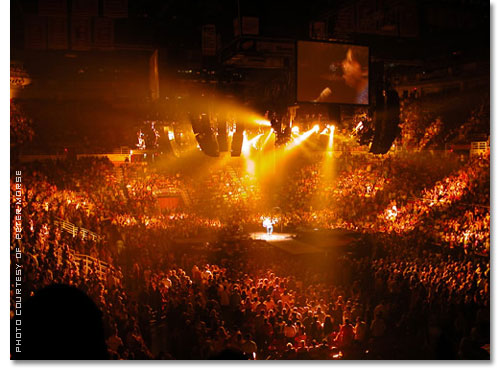
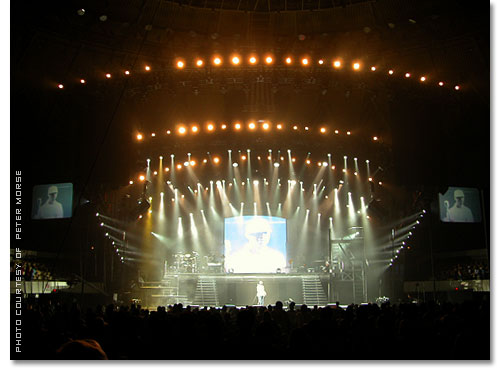
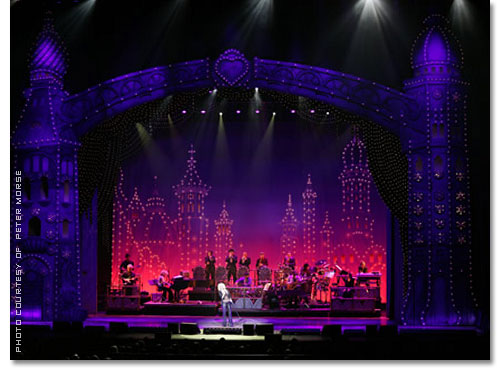
|
MT:
And the crowd...
PM:
You know what, you have a good point right there, I'd say
75% of the energy from those shows is the crowd.
MT:
And you also had the chance to lit what is probably the
Madonna concert with most people, the Who's That Girl tour
in Paris at the Parc de Sceaux, with 120.000 people...
PM:
Well that's a piece of history and I'm proud to be a part
of it.
MT: Peter, what are you currently working on?
PM: I had a busy year, this last year I
did Prince, Usher and Bette Middler.
I have to say that's quite a range there. Usher is great.
MT: And he got you another award...
PM: Yeah... And currently I'm on vacation
for a month and half and then I'm starting working for Disney.
I'm doing a couple of their Ice shows and there's a couple
of tours in discussion for the fall which I'm not allowed
to talk about because of confidentiality.
As soon there's a signature on contract I can divulge but
I'm not allowed 'til then.
But no tours in the summer at all. I'll be doing Disney
on Ice and the Ringley Brothers Circus which is a nice change
from concerts, it's more theatrical, a whole different world.
MT: Is there an artist right now you would
like to work with? Maybe someone you didn't have the chance
to work with before, I know it's hard to find one you did
not lit yet but you never know...
PM: Yes, there is one and she's Annie Lennox,
I would die to work for Annie Lennox. And Peter Gabriel
if he ever chooses to tour again. These are my dream artists
I think.
It has always been a goal to work with them. There are others
of course. I had a huge pleasure working with Melissa Etheridge
a few times and I'd like to do that again.
Prince was a dream come true this year and that was wondeful.
Probably he is one of the most difficult individuals I've
ever had to work with but brilliant. A very interesting
character (laughs) but you know the years with Madonna prepared
me for that (laughs).
And it's true, people would "Prince is on a rampage
today" and I'd say "I've seen rampages before"
(laughs).
Actually to be honest with you the years with Madonna prepared
me for Prince (laughs) on a one to one level.
If I couldn't work with Madonna this year Prince was a natural
alternative, it was just great.
MT: Peter it
was great to have you on MadonnaTribe. Thanks a lot for
sharing your knowledge, experience and tour stories with
all our readers.
Best of Luck for all your future projects.
PM: It was a pleasure.
|
|
| |
Copyright
2005 MadonnaTribe
Pictures courtesy of Peter Morse used by permission.
|
|
|
|
|


